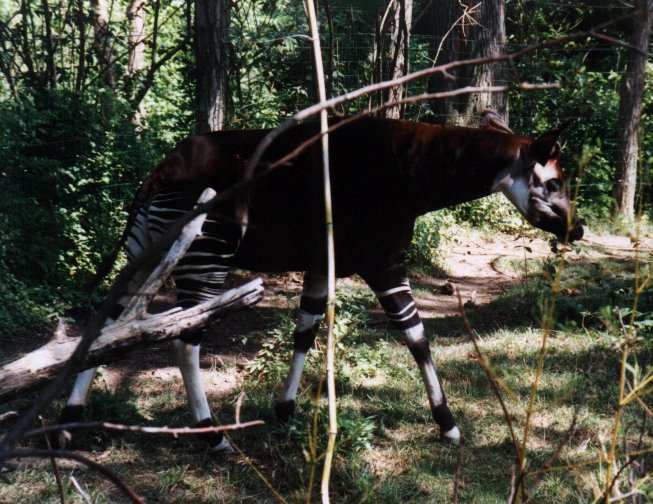Pigmentation: Okapis have a velvet-like coat that is generally a dark chestnut-brown or purplish red color. This helps them blend in with the background of dense vegetation and rotting leaves where it lives. The sides of the face are usually puce. Each Okapi has a unique pattern of zebra-like strips on the rump and the upper parts of its legs. This provides camouflage in the dappled light of the forest and it’s suggested that the stripes help young okapis follow their mothers through the dark forest. It’s suggested the coloring of the Okapi is purely protective, as many scientists claim that in it’s native forest couldn’t not be seen at a distance of more than twenty to twenty-five paces.
Description of adaptation and evolution: Like the giraffe, an okapi’s body slopes down from the shoulders and the legs are long, which allows them to reach higher foliage when browsing. However, they’re not as tall as giraffes, because in the rain forest, there are trees with branches hanging down and many obstacles to dodge. Okapis need their shorter legs and necks to help them swerve and maneuver around these obstacles. The males have horns, and the females do not. The male’s horns are covered by skin and are short so they won’t get tangled in forest branches. The Okapi also has large ears that can rotate independently to help alert it of anything nearing it. Like it’s giraffe cousin, the Okapi has a long, prehensile black-blue The long and mobile muzzle of the Okapi appears to be adapted for feeding on the low forest under-wood and vegetation. The tongue is also used for grooming, as it is one of the few mammals that can lick its own ears. Also, an Okapi’s fur is oily, allowing water to slide right off, keeping it dry on rainy days.
Mating Strategies: In the wild, Okapis are primarily solitary, coming together only for mating. Dominant Males use their scent glands just above the hooves to leave a scented trail through the forest. This establishes their home range, and they will mate with females who pass through their territory. Since the Okapi is so discreet, the only information we have about their mating rituals is what had been seen while they’re in captivity. However, it’s believed that one of the only times a female will vocalize is when she’s ready to breed. The partners will begin courtship by circling, sniffing, and licking each other. Eventually, the male asserts his dominance by extending his neck, tossing his head, and thrusting one leg forward. This display is followed by mounting and copulation. After mating, the male and female part.
Summary: Each adaptation described above is essential in order for the okapi species to thrive and grow. By the laws of natural selection, over hundreds of years, the animal that exhibited these traits survived the best, and passed on their traits to their children, such as an okapi with an abnormally long tongue. That okapi would have been able to reach foliage that others could not, thus surviving and having offspring with equally long tongues. Thus we have an adaptation. The entire being that is an okapi is basically one giant adaptation from what we know as a huge giraffe that thrives on the savannah to a smaller version that quietly makes its home in the dense rainforest.
